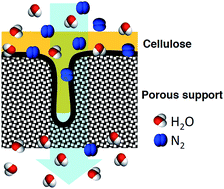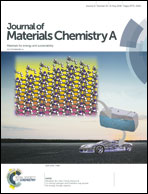High dehumidification performance of amorphous cellulose composite membranes prepared from trimethylsilyl cellulose†
Abstract
Cellulose is widely regarded as an environmentally friendly, natural and low cost material which can significantly contribute to the sustainable economic growth. In this study, cellulose composite membranes were prepared via regeneration of trimethylsilyl cellulose (TMSC), an easily synthesized cellulose derivative. The amorphous hydrophilic feature of the regenerated cellulose enabled fast permeation of water vapour. The pore-free cellulose layer thickness was adjustable by the initial TMSC concentration and acted as an efficient gas barrier. As a result, a 5000 GPU water vapour transmission rate (WVTR) at the highest ideal selectivity of 1.1 × 106 was achieved by the membranes spin coated from a 7% (w/w) TMSC solution. The membranes maintained a 4000 GPU WVTR with a selectivity of 1.1 × 104 in mixed-gas experiments, surpassing the performances of previously reported composite membranes. This study provides a simple way to not only produce high performance membranes but also advance cellulose as a low-cost and sustainable membrane material for dehumidification applications.



 Please wait while we load your content...
Please wait while we load your content...